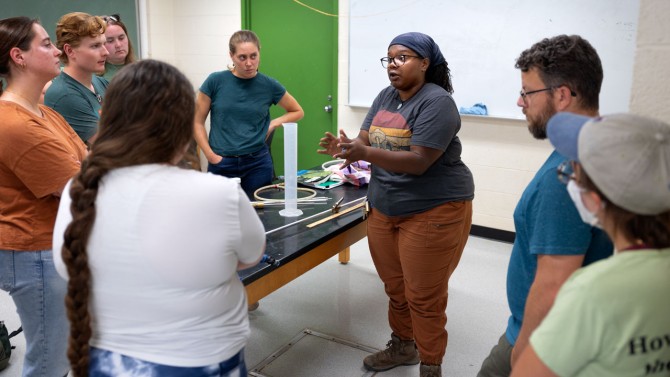
Doctoral student Maria Gannett practices a walking cadence with a sprayer full of water.
Get off my awn: Cornell Weed Team to compete in Ontario
By Blaine Friedlander, Cornell Chronicle
While varsity sports take a summer respite, the Cornell Weed Team is preparing for the Northeastern Weed Science Society’s Collegiate Weed Science Contest – an international competition among the finest agricultural students in the region – on July 27 in Plattsville, Ontario.
To the seven graduate and four undergraduate students on the Cornell team, who face endless marijuana wisecracks about weed from nonscientists, the tournament is no joke.
“At the contest, the Cornell students will be out in the field, gaining experience to show industry judges their overall knowledge,” said Lynn Sosnoskie, a team faculty adviser and assistant professor in weed ecology at Cornell AgriTech in Geneva, New York, part of the College of Agriculture and Life Sciences (CALS).
“This is weed science – not as a curated classroom exercise,” she said, “but as a next step in the student’s professional development. It’s real life.”
More than four dozen Northeastern region students – from colleges including Pennsylvania State University, Rutgers University, Virginia Tech, North Carolina State University and the University of Guelph – will compete. The contest is hosted by Syngenta Canada, Inc., in collaboration with the University of Guelph, at the company’s Honeywood Research Facility.
Cornell doctoral student Aleah Butler-Jones ‘19, who grew up in northern New Jersey, near New York City, will compete for the fourth time. Through Sosnoskie’s lab, Butler-Jones studies how to nix weeds on commercial farms using electricity.
“Weeds are omnipresent,” Butler-Jones said. “They are a very interesting group of organisms. Not to anthropomorphize them, but weeds are perseverant, persistent and tough. Despite our constant efforts to kill them, weeds not only survive, but thrive, often in highly disturbed environments. That’s impressive and downright cool.”
Events for the all-day contest are weed identification, in-field and on-your-feet problem solving, as well as application technology and sprayer calibration – which involves calculating how much herbicide to use. You need to walk consistently at a steady pace while using a sprayer. You don’t want to overspray or underspray.
Butler-Jones, as one of the senior members on the team, helped the others prepare. She recently spent an hour poring over the spray calibration calculations. For walking and spraying consistently at 3 mph, Butler-Jones suggested a cadence to hum the tune “Stayin’ Alive” from the movie “Saturday Night Fever.” While spraying in practice, she steadily walked the 50-foot distance – and hummed – perfectly in 11 seconds.
The other graduate-level team members work in Cornell labs. Bethany Schulteis ’21 conducts research with robotic visual sprayers and Laura Pineda-Bermudez ’18 will survey farmers who want to use new tools to control weeds. Sophie Westbrook examines new ways to use milkweed in integrated pest management, while Patrick O’Briant ’20, a U.S. Air Force veteran, aims to mitigate the negative effects of climate change and boost productivity of our food systems.
Maria Gannett, M.S. ’16, focuses on using soil microbes to enhance crop plants relative to weed competitors, while Uriel Menalled, M.S. ’20, examines mechanisms in weed-crop competition.
The undergraduate team members are Elizabeth Fitzgerald ‘22, Michael Lovier ‘24, Rebecca Stup ‘23 and Megan Wittmeyer ‘22.
Often unsung heroes, weed scientists are critical to feeding New Yorkers and the nation, as they help farmers bring consumers food.
As New York’s dairy industry ranks third in the nation, grain and forage crops occupy more than 95% of the state’s cropland, providing a critical foundation for agriculture, according to Antonio DiTommaso, professor and chair in soil and crop sciences at the School of Integrative Plant Science (CALS). Since 2000, he has been the faculty adviser for the weed science team, which competes annually.
Grain and forage crops represent an annual value of $2.5 billion to New York, he said.
“The students are not bound to the classroom, they are out in the fields with their professors,” he said. “The New York state agricultural sector and the state’s economy depends on training new weed experts to help these field and forage crops, and other crops like fruits and vegetables, stay healthy.
“The students represent what Cornell does as a land-grant university,” DiTommaso said. “It’s a big economic impact.”
Sosnoskie emphasized the professional development. “The connections that our students make now are going to be invaluable later in their lives,” she said. “When it comes time for problem solving and they get questions for which they have no answer, they’ll know someone in this small weed world – someone they know personally – who may have the solution.”
Team travel was funded by the School of Integrative Plant Science. DiTommaso and Sosnoskie are faculty fellows at the Cornell Atkinson Center for Sustainability.
Get Cornell news delivered right to your inbox.
Subscribe

